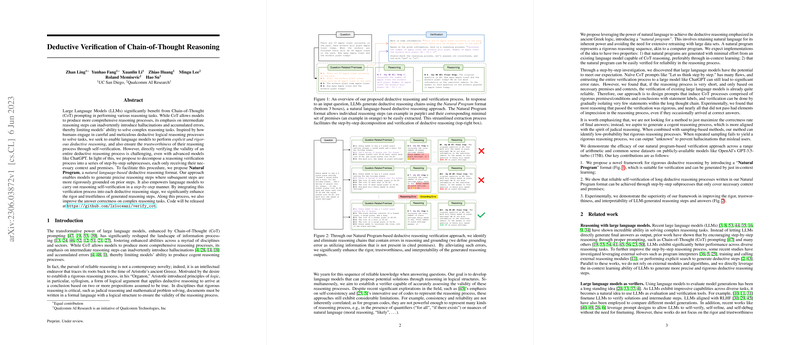Deductive Verification of Chain-of-Thought Reasoning
The paper "Deductive Verification of Chain-of-Thought Reasoning" explores enhancing LLMs through a rigorous verification approach that mitigates common issues associated with Chain-of-Thought (CoT) prompting. While CoT prompting aids in producing comprehensive reasoning, it is susceptible to hallucinations and errors, necessitating a reliable verification mechanism.
Overview
The authors address a significant limitation of LLMs, which, despite their capabilities, often stumble on cogent reasoning due to accumulated errors in intermediate steps. Inspired by human deductive reasoning processes, this paper introduces a structured approach to break down reasoning verification into manageable subprocesses. This is achieved through the introduction of the "Natural Program," a format designed to enable precise and valid reasoning steps.
Methodology
The Natural Program format serves as the cornerstone of this approach. It ensures that each reasoning step is explicitly supported by necessary premises, curtailing instances of extraneous information that may hinder logical deductions. By leveraging this structured format, models are trained to perform reasoning verification iteratively, effectively identifying and addressing errors at each step before proceeding.
Significant emphasis is placed on decomposing the verification process. Rather than attempting to validate an entire reasoning chain at once, the paper advocates for a step-by-step confirmation, promoting accuracy and reducing the likelihood of oversight. The Natural Program format ensures that LLMs can self-verify, enhancing both the rigor and trustworthiness of the reasoning process.
Experimental Results
Experiments conducted across various datasets, particularly in arithmetic and commonsense reasoning, demonstrate the framework's efficacy. The application of deductive verification markedly improved the correctness of solutions on complex reasoning tasks, as evidenced by numerical evaluations on benchmarks such as GSM8K and MATH. Notably, the rigorous format allowed for coherent and traceable reasoning paths, improving overall performance.
Implications and Future Work
The implications of this research in AI are substantial. By instilling a rigorous verification method, LLMs can potentially be adapted to domains that demand high accuracy and reliability, such as legal reasoning or scientific research. Additionally, the reduction of hallucinations—a persistent issue in LLM deployment—enhances user trust and model applicability.
Future developments may focus on further refining the verification process, perhaps extending the Natural Program format to accommodate even more complex reasoning structures or integrating additional modules that allow context adaptation without retraining. Another avenue could involve exploring alternative means of detecting and addressing context irrelevancies in reasoning, thereby pushing the boundaries of what LLMs can achieve in terms of precise and reliable outputs.
In conclusion, the paper's contribution is a significant advancement towards creating more reliable and trustworthy AI systems through meticulous deductive verification of CoT reasoning, setting a foundational paradigm for future enhancements in LLM reasoning capabilities.
